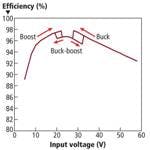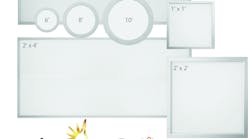This article was published in the April/May 2012 issue of LEDs Magazine.
View the Table of Contents and download the PDF file of the complete April/May 2012 issue, or view the E-zine version in your browser.
+++++
The high lumen output available in high-brightness (HB) LEDs, along with soaring efficacy, is opening a broad variety of application segments to solid-state lighting (SSL). Falling component prices in the HB LED sector provide further incentive for adoption leading product manufacturers requiring a light source to turn to LEDs. A lot of the recent discussion on SSL has centered on the general illumination application, and indeed that will be an extremely large market segment. There are also a number of more-niche applications that introduce unique design challenges such as support for large strings of LEDs in series or very high drive currents. Given the growth potential in such applications, let’s examine the challenge of driving LEDs in automotive headlights and high-power applications such as projectors.
The value proposition for SSL in applications such as headlights or projectors is similar to the case of general illumination. Energy efficiency is a huge advantage. Moreover, long life of the source and the elimination of maintenance in terms of replacing lamps is also an important advantage that LEDs deliver relative to legacy sources.
Let’s consider the automotive headlamp application. Today, most autos still use incandescent light bulbs for headlights. However, this dominance is under pressure from both high intensity discharge (HID) lamps and HB LED headlights going forward.
HID options include all of the light-source technologies used in general lighting such as High Pressure Mercury Vapor, High Pressure Sodium, Low Pressure Sodium and Metal Halide (MH). HID Xenon lamps, essentially MH sources, were first introduced for use as an automotive headlight in the late 1990s. However, they are very expensive to produce and make, so their use has been limited to high-end vehicles. HB LEDs are poised to bring the advantages of Xenon lamps in terms of brightness to a broader base of autos.
Headlight drive options
The simplest LED headlamp designs use a series string of LEDs. For example, you can realize a design using a string of 18 LEDs with 350 mA drive current to implement a light that dissipates around 25W. Such a design would provide sufficient light output in mainstream autos.
A driver that supports variable input and output voltage is necessary. One way to realize such a design is to use the LT3956 LED driver IC. The IC implements a DC/DC converter designed to operate as either a constant-current or constant-voltage regulator. LEDs require a constant-current implementation as depicted in Fig. 1.
The IC features an internal low-side, N-channel power MOSFET rated for 84V at 3.3A and is driven from an internal regulated 7.15V supply. The fixed-frequency, current-mode architecture results in stable operation over a wide range of supply and output voltages. A ground-based referenced voltage feedback (FB) pin serves as the input for several LED protection features. A frequency adjust pin allows the design engineer to program the frequency over the 100-kHz to 1-MHz range to optimize efficiency, performance or external component size.
The LT3956 senses the output current at the high side of the LED string. High side sensing is the most flexible scheme for driving LEDs, allowing boost-, buck-, or buck-boost-mode configurations. You can also use the PWM input to support dimming with ratios up to 3000:1, or the CTRL input for analog dimming.
Smart headlights
The high-end of the automotive segment is undergoing a lot of innovation in LED headlight design, For example, LEDs can offer brighter output yet also support automatic dimming for glare reduction. Such applications demand brighter components and adaptive control capabilities.
Consider a design that utilizes seven LEDs driven at 2A. The output voltage of the driver must be in the 25V range yielding a 50W design. Again the driver must operate from a variable input voltage.
Fig. 2 depicts one possible design. The LT3791 implements a synchronous buck-boost DC/DC LED driver that can deliver over 100W with an input range of 4.7V to 60V. The regulated 2A drive current is provided by a single inductor.
The integrated four-switch, buck-boost controller is the key to the driver IC operating from inputs above, equal to, or below the output voltage. Such operation is necessary in stop/start, cold crank and load dump scenarios. The converter must seamlessly transition between buck, pass-through and boost operating modes. Fig. 3 depicts the operating modes and efficiency relative to the input voltage.
The circuit depicted in Fig. 2 can be augmented with PWM or analog dimming capabilities to support desired features such as automated dimming in an automobile. Efficiency tops out at 98% and is above 90% across the bulk of the input voltage range.
High-current LED applications
There are still other end market applications that require even greater drive current for LEDs, some with currents in excess of 10A. Examples include DLP projectors, laser drivers, and architectural or entertainment lighting. However, delivering currents greater than 10A can bring a host of design problems, not the least of which is the thermal management aspects within the end product itself.
The LT3743 enables three-state current control which makes it a good match for the previously-mentioned, color-mixing requirements of DLP projectors. The circuit supports very fast (<2 µsec) transition time between current levels that optimizes color mixing resolution. That same capability supports very fast current pulsing in laser driver applications.
You can realize the current states and use the dimming capability in the circuit. The LT3743 offers both PWM and CTRL_SELECT analog dimming, enabling 3,000:1 dimming capability at three separate LED current levels. The driver design maintains current accuracy of +6%.
In terms of thermal issues, the driver design can simplify the thermal-mitigation problem via efficiency. The LEDs must still be cooled. But the circuit in Fig. 4 delivers electrical efficiency as high as 95%, thereby eliminating any need for external heat sinking on the driver and significantly simplifying the thermal design of the system.
Manufacturers of LEDs now offer packaged LEDs over a broad range of operational characteristics including larger emitters that can handle very high drive currents. The key in HB LED driver design is delivering the necessary lumens of light output from the lowest possible level of power without causing significant thermal design constraints. The driver knowledge base, and the driver IC selection, is rapidly expanding to match the breadth of the LED options. Carefully choose a topology and implementation for your specific application, and you can deliver the energy efficiency, performance, and long life attributes now expected in SSL.









